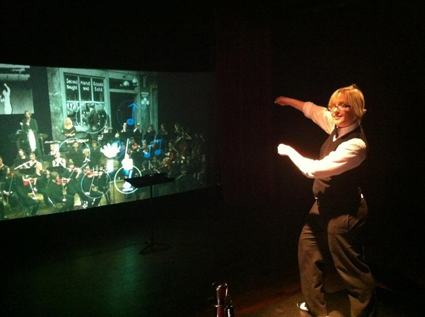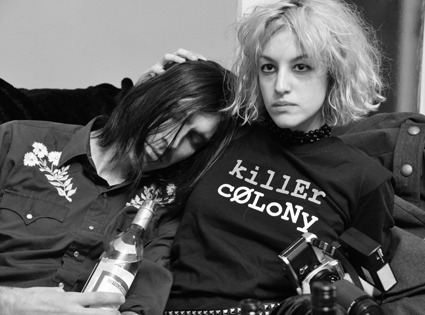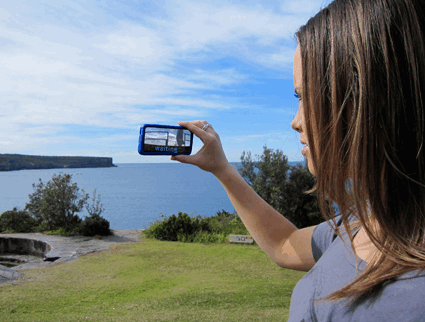filmmaking by degree: new modes of production
tina kaufman: postgraduate filmmaking
THE NEW DIGITAL TECHNOLOGIES MAY HAVE MADE FILMMAKING MORE ACCESSIBLE AND ECONOMICAL, BUT IT’S STILL A COSTLY AND COMPLEX PROCESS. HOWEVER, NOW THAT A FILM OR NEW MEDIA WORK CAN BE SUBMITTED AS THE PRINCIPAL MEANS OF ASSESSMENT IN THE PRACTICE-LED POSTGRADUATE DEGREES OFFERED AT UNIVERSITIES WITH SCREEN PRODUCTION COURSES, THIS HAS BECOME NOT ONLY A PRACTICAL WAY OF MAKING A FILM OR A MEDIA PROJECT, BUT ONE WITH OTHER ADVANTAGES.
Producing work in this way gives the maker the time to do substantial research, to think and to rethink a work, and even to change the concept completely. It provides facilities and technology to experiment with new formats and practices and to fine-tune technical aspects of the work. And most of all it provides space and a stimulating and supportive environment. The range and diversity of projects coming out of universities nationally is impressive: here are just a few.
myorchestra: real time music game

My Orchestra, director Pru Montin
Pru Montin’s Master of Screen Arts project, which she is making at AFTRS, is myOrchestra, a real time music game demonstrating how physical gestures can create music. It’s mainly designed for children, but she believes that it could have other applications such as aiding filmmakers in working out the sort of music they want for a film: “It should be the perfect tool to see if the music is working for the film.”
On the screen is a concert hall and orchestra: the player, taking the role of conductor and/or composer, gestures to the screen to choose the players and their instruments and create the music. The idea came after a group of children in her music class surprised her with an impromptu performance with their own orchestra made up of toys and pots and pans. “Children really relate to music and love to explore the sounds of different instruments; they’re fascinated by and really good at performance. They relate so physically to music, love to stand behind the conductor and wave their arms around. But who can afford an actual orchestra?” she asked herself, and then reasoned that Kinect, where you can control things by just waving your hands, provided a perfect way to give children access to an orchestra and its instruments. Through research and experimentation she created the game, writing the music while developing the programming code and the look of the user experience.
“We’ve got 36 pieces of music, from short, sharp stabs to longer chords, which can be used to explore the characteristics of the different instruments, demonstrating by exploiting each particular phrase in each instrument how you achieve their distinctive sounds. It features what the instruments do well. We’re still testing, ironing out bugs in the software. We need to make it foolproof before we really show it off, “ she says.
After completing her first degree at Monash, Montin came to AFTRS and did her Graduate Diploma in Screen Music. She believes that “AFTRS is the only place where you can explore music for film in a really practical way, especially because you can work with other filmmakers at the same level; the students’ films that I worked on in the Grad Dip are still doing the festival circuit.”
johnny ghost: feature film & thesis

Johnny Ghost, director Donna MacRae
photo courtesy the artist
Johnny Ghost, director Donna MacRae
Donna MacRae has recently finished her PhD at Monash University in Melbourne, as part of which she made a feature film, Johnny Ghost, which is having a successful run on the alternate festival circuit, picking up awards, including Best Feature at the South Texas Underground Film Festival and Film with Most Heart at the PollyGrind FIlm Festival in Las Vegas. She believes “the PhD film heralds a new mode of production, offering filmmakers a rich tapestry of ideas in which to make their work.”
Having studied film at VCA, gone on to do a Masters of Fine Art at Monash “for more visual understanding,” MacRae realised that if she did her postgrad degree in the Faculty of Art and Design at Monash, “I could meet the requirements with a 30,000 word thesis and some practice. So I decided to make a film, blending the intellectual rigour of writing with the visual creativeness of filmmaking. It was the first time anyone had done it there, but I’ve gained my doctorate and the film has gained some critical recognition.” Because Monash has no film production facilities, she used a very small but professional film crew on a fast and streamlined shoot; the university offered locations, paperwork and the financial support of her scholarship. Through the PhD she had a position lecturing undergraduate students, and many of them worked as extras on the film.
Her thesis, “Projecting Phantasy—The Spectre in Cinema,” is on ghosts in film, a subject that’s always interested her. She found the academic research and the interaction with other students really stimulating: interest in ghosts crosses over into different areas, and “there’s so much writing, not only on ghosts in film, but on cinema as a ghost itself.” In Johnny Ghost, Millicent, a professional musician, lectures in music, is popular with the students and loves her job. But when she decides to have an old tattoo removed from her shoulder, shadows from her past won’t let her move on so easily—her ghost is one she has carried with her. MacRae chose “to shoot the film in long takes and black and white to give it an otherworldly, real time feel. I wanted to give the audience time to feel Millicent’s grief and also to experience unease.” And she hasn’t quite finished with ghosts: her next project will be a ghost western.
island home: documentary & doctorate
Jeni Thornley’s Island Home Country is a 52-minute documentary, a poetic cine-essay about race and Australia’s colonised history and how it impacts on the present, exploring various ways of dealing with the legacies of British colonialism and its race-based policies. It was made through a very consultative process, with Respecting Cultures (Tasmanian Aboriginal Protocols), and suggests an evolving shift in Australian historical narratives, from the frontier wars to one of diverse peoples working through historical trauma in a process of de-colonisation.
Jeni Thornley is a filmmaker of many years’ standing (her short film Maidens won a Greater Union Award at the 1978 Sydney Film Festival), a teacher and writer. It was while she was teaching a course on Issues in Documentary at UTS that something about teaching the subject “triggered my own awareness of the connection between theory and practice. Some of the thinking I was doing in teaching the course made me think of a different way to make a film (within the university). I got a scholarship, facilities and supervision. In fact Sarah Gibson (Senior Lecturer, Creative Practices Group, UTS) was not only my principal supervisor but offered a creative alliance; she was a measured and thoughtful supervisor and has been like a creative consulting producer, nurturing the project.”
Thornley’s Doctorate (DCA) took seven years; the film took four years to make. “I did try and get a TV pre-sale and some support from Screen Australia, but I got knocked back, but I get spurred on by rejection,” she comments, adding that she “embraced the university as a home and a working environment. When you make a film in this way, later in a career, there’s a certain maturity—you go into it with an acute consciousness of combining your early work and the reading and writing that went into that, to achieve a creative fertilisation between theory and practice. That’s something the industry doesn’t support—doesn’t even recognise, really. And at the university I found a community of scholars that was enormously nourishing. One of my fellow students was writing on and researching [Indian filmmaker] Satyajit Ray, and I learnt so much reading her work and spending time with her. Someone else was researching Chinese documentary and held regular screenings—the potential for such interdisciplinary connections is great and the environment is tremendously invigorating and exciting.”
As well as filmmaking and teaching, Thornley finds being an independent scholar, delivering papers at conferences, writing chapters for books, all very rewarding. Her film was bought by the ABC and screened in 2009 and 2010, and has been to a number of festivals. She and the film have just returned from the Anthro Film Festival (Vietnam Institute of Culture & Arts Studies) in Ho Chi Minh City, an international anthropological festival screening works by filmmakers from Vietnam and other Asian countries, with a few by Western filmmakers (see Thornley’s report in RealTime 113, Feb-March, 2013).
notes for walking: locative artwork

Notes for Walking, Megan Heyward, DCA, UTS Sydney
courtesy the artist
Notes for Walking, Megan Heyward, DCA, UTS Sydney
Megan Heyward is an award-winning Australian digital media writer, artist and educator whose work is at the intersection of storytelling and new technologies. For interactive media and different screens she creates innovative projects to reconfigure narrative, and her works have been widely exhibited in Australia and internationally. She was an academic at UTS when she decided to create a new project as part of her Doctorate in Creative Arts, and believes that making such a project as part of her DCA allowed her to be more experimental, to spend more time and develop her ideas on a project that really had no funding.
Notes for Walking is the result; it’s an innovative locative artwork situated at Middle Head National Park and Mosman Art Gallery as part of the Festival of Sydney next January. Visitors will use their mobile phones to discover a set of short video ‘notes’ electronically tagged to actual locations and features of landscape as they explore the old naval fortifications at Middle Head. Working “with the spectacular intersection of land, sea and sky at Middle Head, and the emerging capacities of augmented reality and location-based technologies, Notes for Walking will provide an intriguing exploration of a remarkable landscape,” a combination of artwork and treasure hunt. Visitors will be encouraged to take photos and submit their own messages and responses as they explore the locale. A mixed media installation involving video and audio will be encountered in The Cube media space in Mosman Art Gallery, including photos and texts sent electronically from Middle Head by visitors.
It’s clear that these works and many more have come through a process that offers not only a new mode of production, but one that offers time for research, experimentation and rumination, a stimulating, supportive environment and some very different forms of assistance. It’s an exciting development, and one that should result in innovative and thoughtful new work in many different forms.
RealTime issue #112 Dec-Jan 2012 pg. 20






